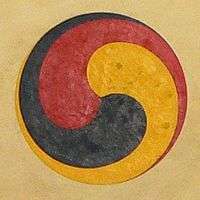Ground (Dzogchen)
In Dzogchen ground (Tibetan: གཞི, Wylie: gzhi ; IAST: āśraya[1] or sthāna[note 1][note 2]) is the primordial state. It is an essential component of the Dzogchen tradition for both the Bonpo and the Nyingmapa.[2][3] Knowledge of this Ground is called rigpa.[note 3]
Etymology
The Tibetan: གཞི, Wylie: gzhi has been rendered as 'Base', 'Basis', 'Ground' and 'Ground of Being' amongst other English glosses. According to Dudjom the original Sanskrit-term is āśraya (IAST; Sanskrit Devanagari: आश्रय; Etymology: आ- √श्रि),[4][note 1] but it could also be sthāna.
Sam van Schaik states that gzhi is to be distinguished from kun gzhi. In the Seminal Heart series a distinction is made between kun gzhi, c.q. ālaya, "the base of it all", the samsaric basis of consciousness, of all the samsaric appearances; and gzhi, "the nirvanic basis known as the ground."[5][note 4]
Three qualities
According to the Dzogchen-teachings, the Ground or Buddha-nature has three qualities:[6][7]
- ngo bo, "essence", openness or emptiness (Wylie: ngo bo stong pa ),
- rang bzhin, "nature", luminosity, lucidity or clarity (as in the luminous mind of the Five Pure Lights) (Wylie: rang bzhin gsal ba ),
- thugs rje, "power", universal compassionate energy (Wylie: thugs rje kun khyab ), unobstructed (Wylie: ma 'gags pa ).
(In Goodman & Davidson 1992,) Herbert V. Guenther points out that this Ground is both a static potential and a dynamic unfolding. They give a process-orientated translation, to avoid any essentialist associations, since
ngo-bo (facticity) has nothing to do with nor can even be reduced to the (essentialist) categories of substance and quality; [...] rang-bzhin (actuality) remains open-dimensional, rather than being or turning into a rigid essence despite its being what it is; and that thugs-rje (resonance) is an atemporal sensitivity and response, rather than a distinct and narrowly circumscribed operation.[8]
The Prayer of Kuntuzangpo
Beings are trapped in samsara by not recognizing the ground. The Prayer of Kuntuzangpo from the Gonpa Zangthal states:
From the beginning you beings are deluded
Because you do not recognize
The awareness of the ground[9]
See also
Notes
- 1 2 According to A Dictionary of Buddhism, Oxford University Press, 2003, 2004[web 1] "āśraya" is a synonym for ālaya-vijñāna, the "store-house-consciousness.
- ↑ Other translations of gzhi: Chinese: 基 (Pinyin: Ji); Korean 의지 (ŭiji); Japanese:エジ (eji)
- ↑ Wylie: rig pa; IAST: vidyā)Template:Dudjom Rinpoche
- ↑ Sam van Schaik: "....the Seminal Heart distinction between two types of basis, the nirvanic basis known as the ground (gzhi) and the samsaric basis of consciousness, the ālaya (kun gzhi).[5]
References
- ↑ Longchen Rabjam 1998, p. 288.
- ↑ Rossi 1999, p. 52.
- ↑ Dudjom Rinpoche & Jikdrel Yeshe Dorje 1991, p. 354.
- ↑ Dudjom Rinpoche & Jikdrel Yeshe Dorje 1991, p. 354 Index of Technical Terms.
- 1 2 Schaik 2004.
- ↑ Tenzin Wangyal Rinpoche 2001, p. 44.
- ↑ Petit 1999, p. 78-79.
- ↑ Goodman & Davidson 1992, p. 14.
- ↑ Ranjung Yeshe 2006, p. Chapter 9.
Sources
Published sources
- Dudjom Rinpoche; Jikdrel Yeshe Dorje (1991), Gyurme Dorje with Matthew Kapstein, ed., The Nyingma School of Tibetan Buddhism: its Fundamentals and History. Two Volumes. Translated and, Wisdom Publications, ISBN 0-86171-087-8
- Goodman, Steven D.; Davidson, Ronald M. (1992), Tibetan Buddhism: reason and revelation, SUNY Press, ISBN 0-7914-0785-3
- Hubbard, Jamie (2008), Original Purity and the Arising of Delusion (PDF)
- Ranjung Yeshe (2006), Quintessential Dzogchen, translated by Kunsang, Erik Pema
- Longchen Rabjam (1998), The Precious Treasury of the Way of Abiding, translated by Richard Barron, Padma Publishing
- Petit, John Whitney (1999), Mipham's Beacon of Certainty: Illuminating the View of Dzochen, the Great Perfection, Boston: Wisdom Publications, ISBN 0-86171-157-2
- Tenzin Wangyal Rinpoche (2001), Het wonder van onze oorspronkelijke geest. Dzokchen in de bontraditie van Tibet (Dutch translation of "Wonders of the Natural Mind"), Elmar BV
- Rossi, Donatella (1999), The Philosophical View of the Great Perfection in the Tibetan Bon Religion, Snow Lion, ISBN 1-55939-129-4
- Schaik, Sam (2004), Approaching the Great Perfection: Simultaneous and Gradual Methods of Dzogchen Practice in the Longchen Nyingtig (PDF), Wisdom Publications Inc.
Web-sources
- ↑ Charles Muller, Tokyo Gakuen University (1997), "āśraya" (accessed 13 May 2011
Further reading
- Lipman, Kennard (c. 1984). "How Samsara is Fabricated from the Ground of Being." Translated from Klong-chen rab-'byams-pa's "Yid-bzhin rin-po-che'i mdzod". "Crystal Mirror V". Berkeley: Dharma Publishing, pp. 336–356 revised edition 1991; First published 1977
- Hubbard, Jamie (1994, 2008). Original Purity and the Arising of Delusion. Smith College. Source: (accessed: Friday April 9, 2010)
